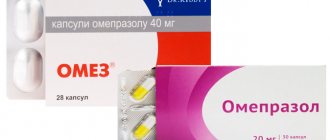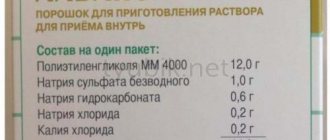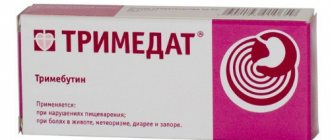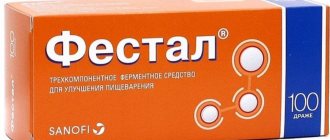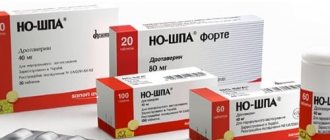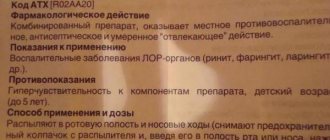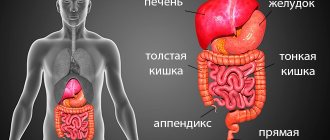Release form, composition and manufacturer
The drug is available only in tablets in dosages of 10 and 20 mg. Tablets containing 10 mg of the main active ingredient are available from the pharmacy without a prescription, but the 20 mg version requires a doctor’s permission.
Pariet contains 9.42 mg of rabeprazole (18.85 mg for a dosage of 20 mg). Additionally, the composition includes other products, using the example of a 10 mg medicine:
- Magnesium oxide – 44.7 mg;
- Manit – 26 mg;
- Hydroxypropyl cellulose, weakly substituted – 13 mg;
- Hypromellose phthalate – 8.5 mg;
- Hydroxypropylcellulose – 4 mg;
- Magnesium stearate – 1 mg;
- Monoglyceride – 0.85 mg;
- Talc – no more than 0.8 mg;
- Titanium dioxide – 0.43 mg;
- Red iron oxide – 0.02 mg;
- Carnauba wax – 0.0015 mg;
- And also edible gray ink.
On the packaging of Pariet you can see the indication of different (Russia), CILAG, AG (Switzerland) and EISAI (Japan). The drug manufacturer is located in Japan and produces tablets under the EISAI brand.
However, the medicine is manufactured to order from Russia, which is confirmed by the registration certificate. The Swiss company produces exclusively packaging for the product.
It is the owner of the registration certificate - the Russian company - who is responsible for the quality of the product, accepts all claims, controls the production process and issues permission to the Japanese and Swiss. And all these companies are indicated in the insert as manufacturers.
Pariet - the main parameters of the pharmacodynamics and pharmacokinetics of the drug
The mechanism of action of rabeprazole (the active ingredient of the drug Pariet) is the same as that of omeprazole.
This is also an inhibitor of sodium-potassium ATPase, which makes it impossible for parietal cells to complete the final stage of hydrochloric acid production. It is well absorbed from the digestive system, but the maximum concentration in the blood is reached somewhat later than in the case of omeprazole - after about three and a half hours.
The bioavailability of rabeprazole is slightly higher, amounting to about fifty-two percent. The half-life is about an hour or even less, but the inhibition of sodium-potassium ATPase activity lasts longer than in the case of omeprazole - up to forty-eight hours, while the rebound phenomenon is not typical for this drug.
In general, omeprazole and rabeprazole are quite similar, however, it should be noted that in some cases the latter drug requires administration in a lower dose, which has a beneficial effect on the incidence of side effects - due to a reduction in the dose, they are observed less frequently.
You should not invent on your own what to replace Pariet with, since the drug was prescribed taking these features into account, and another remedy will require both different dosages and a different schedule for taking the medication to achieve the same effect.
Cost of tablets
Pariet is available in packs of 7, 14 and 28 pieces. The cost depends on the number of tablets in the package and the dosage of the active substance.
| Dosage/number of pieces | 10 mg, 7 pieces | 10 mg, 14 pieces | 20 mg, 14 pieces | 20 mg, 28 pieces |
| Price (average) | From 800 rubles | From 1300 rubles | From 2000 rubles | From 3500 rubles |
Pariet has a sufficient shelf life - 2 years in unopened packaging. For treatment, a dosage of 20 mg of the active substance is often prescribed, which must be taken for more than one month. Buying a large pack of medicine will help save money.
Indications for use of Pariet
Instructions for use of Pariet divide the indications for its use depending on the amount of the active substance. Thus, products with 10 mg of rabeprazole are intended:
- To combat symptoms of hyperacidity (belching, heartburn, sour taste);
- For symptomatic treatment of GERD (gastroesophageal reflux disease), which occurs without esophagitis.
Pariet 10 mg of active substance is not intended for treatment, but is used to combat symptoms. Reviews of Pariet, which describe the lack of effectiveness of the drug in the treatment of gastritis, often do not take this factor into account.
Pariet 20 mg is intended for the prevention and treatment of diseases arising from increased stomach acidity.
Gastritis, exacerbation of any kind of ulcer, GERD, reflux esophagitis, as well as stress diseases of the stomach with high levels of acidity - all these diseases in acute form are perfectly treatable with the help of Pariet. It helps fight Helicobacter pylori and can be used to prevent diseases associated with the activity of the bacterium (ulcers, gastritis).
Comparative characteristics
Both drugs are created synthetically and are dispensed from pharmacies according to doctor's prescription. They should be stored out of reach of children in a dark place, Pariet for two, Nolpazu for three years, at room temperature up to 25 degrees.
The bioavailability of drugs is somewhat different. It remains constant throughout the course of treatment. Rabeprazole is bioavailable by 52%, pantoprazole by 77%.
Prescribed medications for the following list of diseases:
- Gastric and duodenal ulcers during exacerbation.
- GERD is a gastroesophageal reflux disease accompanied by pain in the esophagus when swallowing food and acidic belching.
- Different forms of reflux esophagitis.
- Zollinger-Ellison syndrome, which is characterized by increased secretion of hydrochloric acid and high acidity of the stomach.
- To destroy Helicobacter pylori bacteria in patients with stomach ulcers, chronic gastritis, when taken together with two antibiotic drugs.
For gastric ulcers, duodenal ulcers, lesions of the gastrointestinal tract during long-term treatment with anti-inflammatory non-steroidal NSAIDs (indomethacin, aspirin, etc.), Nolpaza is prescribed for preventive purposes.
- Pariet is used to prevent recurrence of ulcers associated with large numbers of Helicobacter pylori.
- During the treatment of peptic ulcers and GERD, one tablet per day is prescribed for 4 – 6 – 8 weeks.
- When treating conditions with pathological hypersecretion, including Zollinger-Ellison syndrome, the dosage of drugs is selected strictly individually (up to 160 mg of pantoprazole and up to 100 mg of rabeprazole) and as clinically necessary. Treatment can be long-term (up to a year).
- Medicines have a similar method of administration. You should take the tablet in the morning, before meals, with water at room temperature. Do not crush or chew the medicine: the enteric coating will help the active rabeprazole or pantoprazole reach the source of inflammation and begin treatment there.
- Both drugs do not affect gastric motility and the process of food digestion; they are absorbed directly through the mucous membrane of the walls of the gastrointestinal tract.
- Drugs are eliminated from the body mainly through urine. The remaining small part of Nolpaza is excreted in bile, Pariet - in feces.
Pariet for the treatment of gastritis
The main goal of treatment of chronic gastritis is to eliminate the pathogenic effect of hydrochloric acid on the walls of the stomach. Treatment of the disease involves the destruction of the Helicobacter pylori bacterium. Pariet has been successfully used to achieve both goals:
- Blocks the production of hydrochloric acid quickly and efficiently;
- The medicine is practically independent of the activity of liver enzymes, thereby reducing interaction with other drugs;
- Helps to completely eliminate the unpleasant symptoms of gastritis (heartburn, shortness of breath, pain) with complex treatment and diet;
- It begins to act on the first day of use, a steady disappearance of symptoms is observed on days 3-4;
- It suppresses Helicobacter activity well, but does not completely eliminate it from the body. In combination with antibiotics, the effectiveness of treatment increases markedly;
- Pariet affects the activity of antibiotics, reducing their dosage and enhancing the antibacterial effect.
The speed at which Pariet works is not related to the amount of active substance (10 or 20 mg) in the prescribed prescription.
Mechanism of action of drugs
In order to understand which of these drugs is better, it is necessary to understand their mechanism of action.
Omez is an antiulcer agent. It reduces the amount of hydrochloric acid in the stomach. Moreover, it does not matter in what way it is released: natural or stimulated. Omez begins to act after 2 hours.
Pariet works in a wider range of stomach acidity, since its absorption does not depend on the various genetic characteristics of the body. It also suppresses the secretion of hydrochloric acid. The degree of absorption of Pariet from the intestines into the blood does not change depending on the time of meal. The effect after taking the first dose occurs within one hour, and the duration of action lasts about a day. Pariet allows doctors to make reliable predictions about improving the health of patients, and even complete recovery.
When a patient, in addition to problems with the digestive system, has other chronic diseases, he is forced to take appropriate medications. Pariet practically does not interact with medications. It affects metabolism less than others, and its active component combines well with them. Therefore, when choosing Omez or Pariet, Pariet wins here.
These drugs should not be prescribed to yourself, without prior diagnosis and consultation with a doctor. Before using them, it is necessary to exclude the presence of tumor formations in the gastrointestinal tract. Since the initiation of therapy with these medications leads to a smoothing of symptoms and a delay in making the correct diagnosis.
Duration of action
When studying the duration of action of Pariet and Omez, it turned out that there is a difference between them.
Secretory activity occurs more slowly after the end of taking Pariet - after 3 days. When treated with Omez, the release of hydrochloric acid reaches its previous level within 5 days. After finishing taking Pariet, the patient does not face such a problem as “withdrawal syndrome”, that is, a sharp increase in stomach acidity does not occur.
Both products have a bactericidal effect. Their use in combination with antibiotic therapy allows you to quickly eliminate associated symptoms and heal all damage to the gastric and duodenal mucosa. This treatment provides long-term remission of peptic ulcer disease.
Contraindications and side effects
Both forms of the drug should not be taken if the patient is hypersensitive to the main active ingredient or additional substances. Pariet is also contraindicated in other conditions:
- Breastfeeding and pregnancy;
- Children under 12 years of age (20 mg), children under 18 years of age (10 mg);
- Use with caution in severe forms of renal failure.
There are no contraindications for using Pariet with alcohol, but doctors do not recommend taking alcohol-containing products during the treatment period.
Pariet during pregnancy and breastfeeding
There are no data on the safety of rabeprazole during pregnancy.
Reproduction studies in rats and rabbits did not reveal signs of impaired fertility or fetal development defects caused by rabeprazole; however, in rats, the drug penetrates the placental barrier in small quantities. Pariet should not be used during pregnancy unless the expected positive effect for the mother outweighs the possible harm to the fetus.
It is not known whether rabeprazole is excreted in breast milk. Appropriate studies have not been conducted in lactating women. However, rabeprazole was found in the milk of lactating rats, and therefore Pariet should not be prescribed to lactating women.
Side effects
The incidence of side effects in response to the use of Pariet is relatively low. In most cases, the drug is well tolerated by patients, and complications that arise resolve quickly and do not cause significant discomfort:
- Immunity. Allergic reactions rarely occur;
- Hematopoietic system. Thrombocytopenia, leukopenia and neutropenia rarely occur;
- Metabolism. Hypomagnesemia rarely occurs;
- Liver. Rarely - drug-induced hepatitis, encephalopathy and jaundice with long-term use;
- Kidneys and urinary system. Very rarely – nephritis;
- Skin and surrounding tissues. Rarely – bullous lesions, urticaria. Very rarely - erythema, Stevens-Johnson syndrome and toxic epidermal necrolysis;
- Bones and muscles. Rarely – arthralgia and myalgia;
- Reproductive system. Very rarely - gynecomastia.
Reactions are systematized by frequency of occurrence: very common (1 in 10 patients or more), common (1 case in 10-100 patients), uncommon (1 case in 100-1000 patients, rare (within 10,000 cases), very rare (1 case per 10,001 or more patients).
What are the contraindications?
Considering that Omez and Pariet together are two proton pump inhibitors, their contraindications are similar:
- intolerance to any component contained in the medicine;
- It is strictly not recommended to give drugs to young children. Not a single scientific study has yet confirmed that a fragile child’s body cannot tolerate these medications 100%;
- It is strictly not recommended for pregnant women to take the drugs. Despite the fact that medical experiments on animals have proven that the medicine does not have a negative effect on the development of the fetus, pregnant women should NOT take Omez or Pariet without consulting a doctor;
- It is strictly not recommended to breastfeed during treatment. Experiments with experimental rats showed that during the process of introducing the drug into the body of a nursing animal, the composition of the milk changes.
Possible side effects from Omez and Pariet:
- allergies (most often manifested as skin rashes);
- the appearance of leukopenia and thrombocytopenia;
- systematic pain in the temporal region, “vague” consciousness, apathy;
- diarrhea, flatulence, aching sensations in the stomach.
A clear answer to the question “Which drug to choose?” does not exist. Any medication has contraindications and is prescribed by a doctor in accordance with the characteristics of the patient’s body. The only thing that the patient must remember is that under no circumstances should you diagnose yourself. Before you start taking it, you must be examined for the presence of tumors in the gastrointestinal tract, since Omez and Pariet have a “smoothing” effect, after which it is quite difficult to detect other diseases.
special instructions
Dietary food without aromatic spices, fatty and fried foods, as well as spicy foods significantly increases the therapeutic effectiveness of Pariet. Before treatment with any dosage of the drug, it is recommended to undergo examination to exclude malignant formations in the stomach.
Long-term use without breaks, abuse of symptomatic treatment with a 10 mg dosage leads to the leaching of calcium from the body, the development of osteoporosis and fractures.
During treatment with Pariet, you cannot simultaneously use analogues of the drug or mix drugs to reduce stomach acidity.
Directions for use and dosage
Pariet tablets should be taken whole with water. The activity of the drug does not depend on food or time of day. 10 mg tablets should be taken once a day, preferably in the morning, to effectively suppress unpleasant symptoms and prolong the activity of Pariet throughout the day. If you follow the treatment regimen prescribed by the doctor, the effectiveness of the medicine increases.
If no improvement is observed within 3 days after the start of treatment, an examination by a gastroenterologist is required. Without a doctor, you can be treated with Pariet for no longer than 2 weeks.
Pariet 20 mg tablets require a doctor's prescription and strict adherence to the prescribed treatment regimen. The duration of treatment depends on the form and stage of gastritis, but usually 1 tablet per day is prescribed for at least 4 weeks. The treatment regimen is influenced by concomitant diseases.
Patients with severe forms of renal failure should exercise caution. For the treatment of children over 12 years of age, the same regimen is followed as for adults.
Which is better – Pariet, Omez or Nexium
Doctors say that Omez, a cheap analogue of Pariet for stomach pain, is a first-generation proton pump inhibitor, and the drug in question is the fourth, so its effectiveness and quality are higher. Omez can be used in the treatment of stomach diseases that are not accompanied by pain; it acts within 1-3 days, while Pariet begins to work in 15 minutes.
Like Omez, Omeprazole is a first-generation PPI, so its clinical effectiveness, speed of action and reliability of symptom relief are lower. Omeprazole has a high risk of adverse reactions that are difficult to tolerate. With its help it is difficult to achieve effectiveness in reducing the acidity of gastric juice, so Pariet is preferable.
If previous analogues were not as effective compared to Pariet, then Nexium is superior to it. It is also a PPI, but it treats stomach diseases associated with abnormal secretion of gastric juice more quickly. After treatment with Nexium, relapses are rarely observed. This effect is achieved due to the composition - Nexium contains a levorotatory isomer of the active substance, while Pariet and all other proton pump inhibitors contain dextrorotatory isomers.
Comparison of popular analogues of Pariet
The medicine is quite expensive and sometimes causes critical side effects. In search of an alternative, people buy analogues of Pariet, choose drugs with a different active ingredient and often wonder what is better to use.
Rabeprazole and Pariet: what to choose?
A structural analogue of Pariet with a similar active ingredient, Rabeprazole tablets, are less known, but have the same indications. The cost of a course of treatment with Rabeprazole is much lower, but the reviews differ for the worse. And, conversely, there are people for whom Pariet does not help at all, but Rabeprazole works much better.
Pariet contains additional substances to which a person may be allergic. This must be taken into account when choosing a medicine.
The validity of treatment with the first or second drug depends on the severity of side effects and possible contraindications. In the instructions for both drugs, the possible side effects and contraindications are identical.
Which is better: Nolpaza or Pariet?
The drugs have the same indications for use, but their composition differs markedly:
- Pantoprazole sodium is the main active component of Nolpaza;
- Nolpaza can be used during pregnancy and breastfeeding; Pariet has a clear contraindication for this;
- Nolpaza has a larger general list of contraindications.
Any form of release of Nolpaza requires a doctor's prescription when purchased at a pharmacy.
What to choose: Omeprazole or Pariet?
Omeprazole contains a substance with a similar name, and its production is cheaper than working with rabeprazole. Key differences between the drugs:
- Omeprazole is activated only after entering the acidic environment of the secretory tubules of the stomach;
- Rabeprazole immediately enters the blood, so its activity manifests itself faster;
- The mechanics of metabolism in the liver in Omeprazole is more pronounced, hence the frequent occurrence of side effects, unlike Pariet;
- You need to take Omeprazole at the prescribed time, but Pariet is absorbed regardless of such factors;
- The secretion of hydrochloric acid in the stomach after discontinuation of Pariet is recorded on average on the 6th day, and after omeprazole - within 3-4 days;
- To purchase Omeprazole you need a doctor's prescription.
The prescription of a particular drug depends on the individual course of treatment. However, reviews of the use of Omeprazole agree with the opinion of doctors: when treating concomitant diseases and using other medications, it is better to take Pariet, since rabeprazole has less effect on the absorption of other medications.
The active ingredient Pariet causes much fewer side effects. But the cost of the drug can be 4-6 times higher.
Zulbex or Pariet?
The drug Zulbex cannot be called a cheap analogue of Pariet, but it completely replicates the composition of the Japanese drug. And it is available in the same dosages - 10 and 20 mg. Zulbex should not be used in childhood; otherwise, the contraindications for the medications are similar. The medicine has additional serious side effects:
- Vision problems;
- Peripheral edema;
- Infectious lesions;
- Flu-like syndrome, asthenia;
- Increased excitability;
- Insomnia and depression.
Based on the list of side components, an increased list of contraindications, and in some cases a higher price, we can conclude that Zulbex is no better than Pariet. However, individual body reactions can vary significantly.
Khairabezol or Pariet: which is better?
Khairabezol, like Pariet, is prescribed for the treatment of ulcers and is used for exacerbation of gastritis. The composition includes the same active ingredient - rabeprazole in identical dosages of 10 or 20 mg. The drug can be called almost 100% analogue. Contraindications and side effects for both drugs are approximately the same.
A significant difference between Khairabezol is the cost per pack of tablets. For 30 pieces you need to pay no more than 800 rubles, while Pariet will cost much more. At the same time, reviews of the drug are mostly positive; among the side effects, similarities with Pariet are noted.
Razo or Pariet: which is better for the treatment of gastritis
The drugs belong to the same pharmacological group with an identical composition, only Razo contains additional substances. The cost of tablets starts from 300 rubles. Available in dosages of 10 and 20 mg of the active substance.
You can buy Pariet in a pharmacy with a doctor's prescription (mandatory for a dosage of 20 mg).
Reviews from patients who have used Razo to treat gastritis symptoms are generally positive. Some groups experience side effects that disappear when the drug is changed - diarrhea, headache and nausea.
But people using Pariet develop such side effects no less often. Conclusion: you can try Razo for the treatment of gastritis if Pariet is not affordable or causes discomfort.
Pariet or Controloc for gastritis?
Controloc should absolutely not be used by people under 18 years of age, and its main active ingredient is pantoprazole. Reviews often say that Controloc is good for heartburn caused by gastritis and other gastrointestinal diseases.
However, its range of uses is almost the same as that of Pariet. Many patients use it instead of an expensive drug, because the effectiveness and frequency of side effects of Controloc are almost the same as those of the Japanese medicine.
Drug interactions
https://www.youtube.com/watch?v=ytpressen-GB
In studies in healthy volunteers, no clinically significant interactions were observed between rabeprazole sodium and the following drugs: diazepam, theophylline, phenytoin, warfarin, amoxicillin, clarithromycin, aluminum hydroxide and magnesium hydroxide (gel).
Concomitant use of rabeprazole with atazanavir is not recommended due to the likely significant reduction in the effect of the latter.
When taken simultaneously, rabeprazole reduces the absorption of ketoconazole by 30% and increases the absorption of digoxin by 22%. As a result, when combining these drugs, dosage adjustments may be required.
According to retrospective analysis and pharmacokinetic studies, taking rabeprazole with methotrexate (mainly in high doses) is undesirable due to a possible increase in the concentration of methotrexate and/or hydroxymethotrexate (its metabolite). With this combination, due to the threat of worsening the toxicity of methotrexate, a temporary refusal to take Pariet may be required.
The drug Pariet can interact with other medications, not always bringing a positive effect. Combinations and risks:
- does not affect Warfarin, Phenytoin, Diazepam, Theophylline, antacids, aluminum or magnesium hydroxides;
- increases the time to reach the maximum concentration of Clarithromycin, Amoxicillin;
- reduces the absorption of Ketoconazole, increases the absorption of Digoxin, reduces the effectiveness of Atazanavir;
- inhibits the metabolism of Cyclosporine, increases the concentration of Methotrexate.
